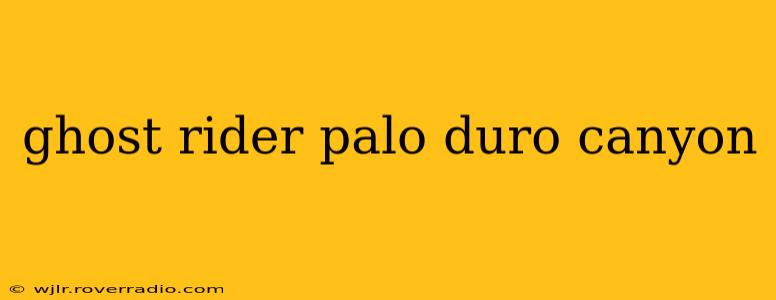Palo Duro Canyon, often dubbed the "Grand Canyon of Texas," is a breathtaking natural wonder steeped in history and folklore. Beyond its stunning vistas and challenging hiking trails lies a captivating legend: the Ghost Rider. This mysterious figure, shrouded in myth and speculation, continues to fascinate and intrigue visitors and locals alike. This article delves into the story of the Ghost Rider, exploring the various interpretations, potential origins, and the enduring power of this Texas legend.
What is the Story of the Ghost Rider of Palo Duro Canyon?
The story of the Ghost Rider varies depending on who you ask. There's no single, definitive account. Instead, a collection of tales and eyewitness accounts contribute to the legend. Generally, the Ghost Rider is described as a spectral horseman, often seen riding a black horse through the canyon at night. Some accounts describe him as a harmless apparition, while others paint him as a more sinister figure, a warning or omen of impending danger. The descriptions often involve a chilling, spectral light emanating from the rider or his horse.
Is the Ghost Rider a Real Phenomenon?
The existence of the Ghost Rider, of course, remains unproven. Skeptics attribute the sightings to natural phenomena, such as unusual atmospheric conditions creating mirages or misinterpretations of natural light and shadows within the vast canyon. Others suggest the stories are embellished tales passed down through generations, growing in intrigue with each retelling. However, the persistence of the legend and the numerous accounts from seemingly credible witnesses fuel the mystery and keep the Ghost Rider a captivating topic of conversation.
What are Some Explanations for the Ghost Rider Sightings?
Many potential explanations for the Ghost Rider sightings exist, ranging from the mundane to the more mystical:
Natural Phenomena:
- Atmospheric Conditions: The unique geography and climate of Palo Duro Canyon can create unusual atmospheric effects that might be misinterpreted as a ghostly figure. Mirages, for instance, are not uncommon in arid regions.
- Light and Shadow: The play of light and shadow within the canyon's deep crevices can create illusions that might be perceived as a ghostly rider.
- Wildlife: Nocturnal animals or their reflections could be misinterpreted, especially in low-light conditions.
Historical Interpretations:
- Historical Figures: Some believe the Ghost Rider represents a historical figure, perhaps a cowboy, outlaw, or even a Native American warrior, whose spirit is tied to the canyon.
- Tragic Events: The canyon's history includes numerous tragic events, including accidents and conflicts. It's possible the Ghost Rider represents the collective spirit of those who perished within the canyon's depths.
Supernatural Explanations:
- Native American Legends: The area has a rich history of Native American presence. The Ghost Rider might be connected to existing Native American legends and folklore, although direct connections remain speculative.
- Spiritual Entity: Some suggest the Ghost Rider is a genuine supernatural entity, a guardian or protector of the canyon.
Where in Palo Duro Canyon is the Ghost Rider Seen?
There's no specific location consistently associated with Ghost Rider sightings. Accounts suggest appearances throughout the canyon, highlighting its vastness and the mystery surrounding the legend. The unpredictability of these reported sightings only adds to the mystique.
When is the Best Time to See (or Maybe Not See) the Ghost Rider?
While there's no guarantee of witnessing the Ghost Rider, many accounts place sightings during nighttime hours, particularly under moonless skies. This adds to the atmosphere of mystery and intrigue.
The Ghost Rider of Palo Duro Canyon remains a compelling enigma. Whether a product of natural phenomena, historical echoes, or something more otherworldly, the legend persists, adding to the canyon's mystique and drawing visitors to explore its depths, both literal and metaphorical. The mystery, perhaps, is as captivating as any purported sighting.
